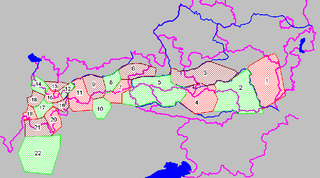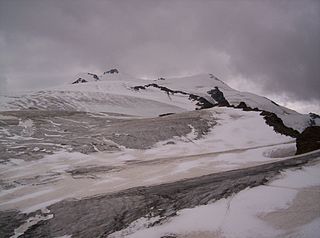The Limestone Alps (German : Kalkalpen) are sub-mountain range of the Alps in Central Europe.
Contents
They are of economic importance, including as a watershed source of drinking water. They have many accessible dripstone and ice caves.
The Limestone Alps (German : Kalkalpen) are sub-mountain range of the Alps in Central Europe.
They are of economic importance, including as a watershed source of drinking water. They have many accessible dripstone and ice caves.
They are roughly 600 kilometres (370 mi) long. The two main groups, Northern and Southern, run parallel to the main Austrian Central Alps (also known as the Central Eastern Alps) mountain ranges, on their north and south. Together with the Austrian Central Alps, the Limestone Alps form the most westerly portion of the Eastern Alps.
The mountain and hill profiles of the Limestone Alps are very varied and range from jagged peaks and sheer rock faces to high plateaus and extensive areas of karst formations.
The numerous ranges of the Limestone Alps are within three mountain groupings, the Northern Limestone Alps, Southern Limestone Alps, and Western Limestone Alps:
The Limestone Alps comprise 3 of the 4 primary regions in the Alpine Club classification of the Eastern Alps. However, they are not used in the proposed SOIUSA classification system.
The Limestone Alps are made of lighter and more porous rock. In addition to limestone, they also contain dolomite, marl, and sandstone. They are unlike the Central Alps, which are mainly composed of crystalline rock (granite and gneiss), or of slate.

The Kitzbühel Alps are a mountain range of the Central Eastern Alps surrounding the town of Kitzbühel in Tyrol, Austria. Geologically they are part of the western slate zone.

The Southern Limestone Alps, also called the Southern Calcareous Alps, are the ranges of the Eastern Alps south of the Central Eastern Alps mainly located in northern Italy and the adjacent lands of Austria and Slovenia. The distinction from the Central Alps, where the higher peaks are located, is based on differences in geological composition. The Southern Limestone Alps extend from the Sobretta-Gavia range in Lombardy in the west to the Pohorje in Slovenia in the east.

The Central Eastern Alps, also referred to as Austrian Central Alps or just Central Alps, comprise the main chain of the Eastern Alps in Austria and the adjacent regions of Switzerland, Liechtenstein, Italy and Slovenia. South of them is the Southern Limestone Alps.

The Kreuzeck Group is a mountain range of the Central Eastern Alps. It may be considered either a separate range or part of the larger High Tauern chain. Administratively, the range belongs to the Austrian states of Carinthia and, in the westernmost part, Tyrol.

The Rhaetian Alps are a mountain range of the Eastern Alps. The SOIUSA classification system divides them into the Western, Southern Rhaetian Alps and Eastern Rhaetian Alps, while the Alpine Club classification of the Eastern Alps places most of the Rhaetian subranges within the Western Limestone Alps.

The Alps form a large mountain range dominating Central Europe, including parts of Italy, France, Switzerland, Liechtenstein, Austria, Slovenia, Germany and Hungary.

The Eastern Alps are usually defined as the area east of a line from Lake Constance and the Alpine Rhine valley, up to the Splügen Pass at the Alpine divide, and down the Liro River to Lake Como in the south. The peaks and mountain passes are lower than the Western Alps, while the range itself is broader and less arched.

The Allgäu Alps are a mountain range in the Northern Limestone Alps, located on the Austria–Germany border, which covers parts of the German states of Bavaria and Baden-Württemberg and the Austrian states of Tyrol and Vorarlberg. The range lies directly east of Lake Constance.

SOIUSA is a proposal for a new classification system of the Alps from the geographic and toponomastic point of view. It was designed by Sergio Marazzi, Italian researcher and author of the Orographic Atlas of the Alps SOIUSA. His book was presented with the patronage of the Italian Alpine Club on 23 Jan 2006, but has yet to receive any formal acceptance.

The Alpine Club classification of the Eastern Alps is a common division of the Eastern Alps into 75 mountain ranges, based on the Moriggl Classification (ME) first published in 1924 by the German and Austrian Alpine Club. The present-day division established for the German-speaking world was compiled by the German, Austrian and South Tyrol Alpine Clubs and published in 1984 and is also used for the basic numbering of Alpine Club maps for mountaineering.

The Western Rhaetian Alps are a mountain range in the central part of the Alps.

The Northern Lower Austria Alps or Lower Austria Alps is the proposed name for a subdivision of mountains in a new, and as yet unadopted, classification of the Alps. They are the northernmost section of the Alps.

The Salzkammergut and Upper Austria Alps is the proposed name for a subdivision of mountains in a new classification of the Alps, which are located in Austria.

The Northern Styrian Alps is the proposed name for a subdivision of mountain ranges in an as-yet-unadopted classification of the Alps located in Austria.

The Tyrol Schistose Alps is the proposed name for a subdivision of mountain ranges in a new, and as yet unadopted, classification of the Alps, located in Austria.

The Western Tauern Alps are a mountain range of the Central Eastern Alps.

The Carnic and Gailtal Alps is a geographic grouping of mountain ranges belonging to the Southern Limestone Alps. They are located in Austria and Italy.

The Partizione delle Alpi is a classification of the mountain ranges of the Alps, that is primarily used in Italian literature, but also in France and Switzerland. It was devised in 1926.

The Gailtal Alps, is a mountain range of the Southern Limestone Alps in Austria. It rises between the River Drava (Drau) and the Gail valley and through the southern part of East Tyrol. Its western group called "Lienz Dolomites", is sometimes counted as part of this range and sometimes seen as separate.

The Wetterstein Formation is a regional geologic formation of the Northern Limestone Alps and Western Carpathians extending from southern Bavaria, Germany in the west, through northern Austria to northern Hungary and western Slovakia in the east. The formation dates back to the Ladinian to Carnian stages of the Late Triassic. The formation is named after the Wetterstein Mountains in southern Germany and northwestern Austria. The center of its distribution, however, is in the Karwendel Mountains. It occurs in the Northern and Southern Limestone Alps and in the Western Carpathians.